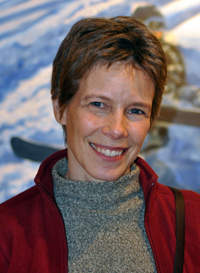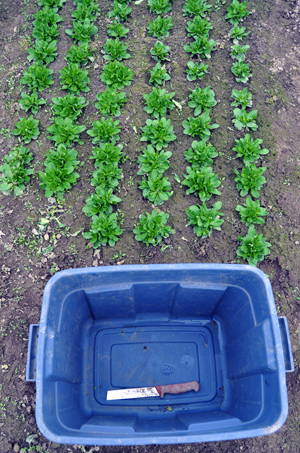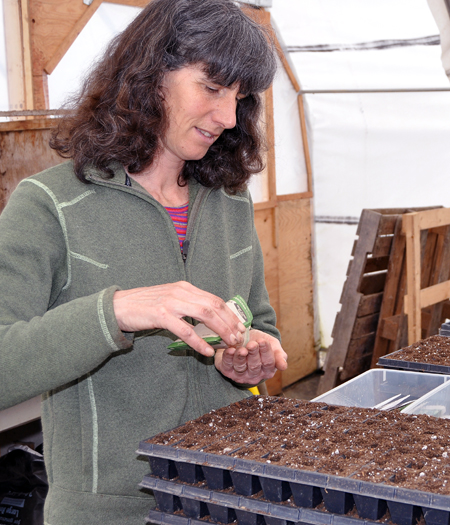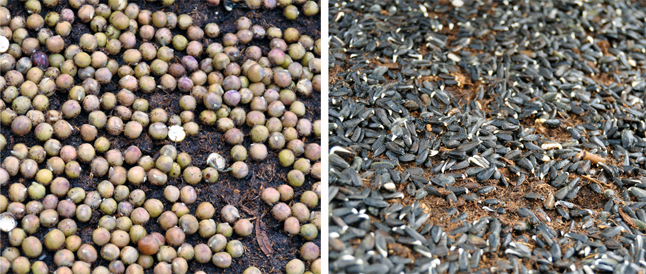

MARA — Have you ever wandered by the winter market, held at the Community Center every other Thursday, and wondered how Hermann and Louise Bruns of Wild Flight Farm in Mara manage to produce green vegetables when we are only at the cusp of spring? At Hermann’s vegetable stand, shoppers can choose from a variety of crops grown on the farm – some root vegetables that have been stored since last fall, but also freshly picked greens, most of which are grown outside in unheated greenhouses. Fresh greens available in April include corn salad, garlic shoots, mixed greens, and pea and sunflower shoots.
How do they do it? Current editor David Rooney and I drove out to Wild Flight Farm to find out.
For Hermann and Louise, providing vegetables in the early spring is about bridging the seasons through storage – the subject of a later article – and carefully-timed, carefully-chosen planting.
Wild Flight Farm has 13 greenhouses, only one of which is heated. These are high tunnels – a larger version of a cold frame – consisting of a metal frame covered with a thick, translucent, plastic sheet, including plastic doors. When we visited, the unheated greenhouses were probably seven to nine degrees warmer than the air outside.
Each of the greenhouses is around 2,200 to 2,500 square feet and together they cover a total of 24,000 square feet – that’s just over half an acre.
The Bruns use three planting strategies to produce vegetables in early spring: choosing cold-weather vegetables; over-wintering some plants; and getting plants started in a heated greenhouse.
A few greens, like hardy corn salad, prefer “cold and miserable weather,” Hermann explained. “Corn salad can take temperatures as cold as -20°

C.” They won’t grow at that temperature but “they will grow once it warms up a bit” – but it can’t warm up too much. When we visited on April 1st, the last of the corn salad was being picked as they were almost ready to go to seed.
Corn salad is popular in Europe, Herman said, but it is not well known here, perhaps because farmers get little product for each plant. These small, sparse clumps of greens are picked by the head, like lettuce, unlike mixed greens which will grow back, permitting a second crop.
Miner’s lettuce is another winter green, native to North America, that the Bruns will try next year. “Gold miners used to use it to fend off scurvy,” Hermann said.
Some vegetables get a kick start in spring because they were planted last autumn – the second strategy. Hermann and Louise planted kale, spinach, lettuce, onions and garlic in the unheated greenhouses in late September or October. The beds of spinach that were planted in September are four to six inches taller and much bushier than those planted in the spring. And the fall-planted green onions will be ready in two to three weeks – that’s four to six weeks earlier than the ones they planted in spring.
Interestingly, lettuce can be overwintered. But it has to be young lettuce, Hermann said. A head of lettuce will not survive but young shoots will.

The third strategy is to germinate seeds in the one greenhouse that is heated with an oil furnace. That’s Louise’s job. All of the farm’s greenhouse plants are transplants so this is where the growing process starts. She seeds all through the growing year. “We don’t quit seeding until well into September,” Hermann says.
Louise plants seedlings in trays of tiny, soil-filled pots. “I used to do my own soil,” she said. “I mixed peat, perlite and vermiculite. There weren’t enough nutrients so I added chicken manure.” But now she buys organic growing soil.
The young plants will be transplanted twice – first into 3 ½- or four-inch pots and then into the ground in the unheated greenhouses. Cucumbers, for example, will be a foot high before they go into the ground. Tomatoes go through a bit of transplant shock but they recover within a day, Louise says.
Two new items that the Bruns will sell at the market soon are pea and sunflower shoots. “This is something people could do at home, Louise said. Pea and sunflower seeds, germinated in water, are then placed on trays of damp peat moss. They grow on the surface of the peat moss until they are about four inches high, when they are ready for the market.

A final way the Bruns stretch the season and maximize the use of their greenhouses is by moving the greenhouses throughout the year. Hermann developed greenhouses on skids that can be pulled by a tractor onto a prepared plot.
“We can start a crop now” under the greenhouse and “in early May we can drag the house off and put it over the tomatoes, long English cucumbers and peppers. We move it back at the end of October when the peppers are finished,” he said.
If a greenhouse were stationary, they could only get two crops a year, at most, out of each one. The spring vegetables would not be ready by the time the tomatoes, peppers and cucumbers need to be planted.
Bridging the seasons is partly about timing and careful crop choices, but Hermann stresses that it’s also about storage. And that is the subject of the next article.
This is the second article in a three-part series on the popular Wild Flight Farm that sells fresh, organic produce at the markets in Revelstoke. For more information on Wild Flight Farm and to subscribe to their e-newsletter, click here.
To read the first article in this series please click here.



